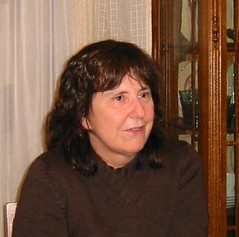On Wednesday, Andrew Schelling noted the importance of the Christmas broadsides that Moe’s Books published during his days (1982-90) working in the store. This is one tradition that may continue to this day, although Andrew also noted the poetry reading series Owen Hill has started in the store, which has grown in a relatively short time into being one of the two major reading series in the East Bay (the other being the 21 Grand series in downtown Oakland).
Broadsides, chapbooks, memorable reading posters are indeed all excellent re-enforcers of any marketing effort to get readers to grasp your commitment both to poetry and to quality. In recent years, quite a few reading series – and at least two different talk series that I can think off – have begun to add some kind of material companion to the event itself. I’ve had several wonderful broadsides done for readings that I’ve given over the years. One – a letterpress version of
Commemorative materials need not represent the high end of fine press printing, as both of those projects do, to show ambition & have an impact. One of the most impressive programs of such reading-related work in the
Fetch contains six poems, nine pages of actual work – right within the range of six to twenty pages favored by the Belladonna series. Here is the title poem:
1
Was it a flaming mouse
that burned Mares' house down
or was it just the wind?
On Tuesday Mares and his nephew
stood by the original version.
Is this plausible?
Fire Chief Chavez said Tuesday
that he thought so.
2
Let's see
your itty-
bitten specificity
fetish,
your mom's phantasmic
what's-it
held conspicuously
under threat.
Day hoists its mesh
of near
approximations,
(its bright
skein of pores.)
Eyes fetch thrown
shadows
Readers of this blog will know already that Armantrout is one of my half dozen favorite poets of all time & this poem is full of evidence as to just why this should be so. The first section is descriptive with that clean, hard edge one associates with the likes of Williams & Oppen at their very best, tho what is here depicted might as easily be the plot for an episode of the X-Files. The image of the flaming mouse is hard to shake once you’ve read it & impossible to see as just setting up that internal rhyme of the second line. The poem’s second section has the familiarity of a
Fetch was released last week, when Armantrout read in the Belladonna series with Laynie Brown and Marjorie Welish, both of whom also have new chapbooks out in this series (tho I’ve seen neither). Overall, the Belladonna series is, and has been, a who’s-who of post-avant women poets: Fanny Howe, Eleni Sikelianos, Kathleen Fraser, Rachel Blau DuPlessis, Norma Cole, Carla Harryman, Tina Darragh, Chris Tysh, Jennifer Moxley, Alice Notely, Eileen Myles, Lydia Davis, Elaine Equi, Maggie Nelson, Summi Kaipa, Anne Tardos, Minnie Bruce Pratt, Leslie Scalapino, Nada Gordon, Catherine Daly – the list just goes on and on. It’s not an accident that American poetry in my lifetime has made the transition from being a male dominated art form (think of the Allen anthology in 1960, with just four women among its 44 contributors) to one in which women hold up more than half of the sky (think of the new Bay Poetics anthology, 59 of whose 110 poets are women). A series like the Belladonna has been both instigator and beneficiary of this transformation. Its chapbooks are small editions – there are just 126 copies of Fetch – and yet 74 of its first 93 books remain available.
It’s also been an excellent week for Armantrout overall, who became, I do believe, the first contributor to In the American Tree to have a poem in the New Yorker, of all places. I take that as a sign, not unlike the fact that my district, where Republicans outnumber Democrats by roughly two to one, just elected its first Democrat to the Pennsylvania State Senate in over a century. Spring really has arrived.






